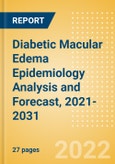Macular edema (ME) is a condition characterized by the thickening and swelling (edema) of the macula, which is the area of the retina that is responsible for central vision. The pathogenesis of ME is complex and multifactorial, and mainly results from the disruption of the blood-retinal barrier, leading to the accumulation of fluid and serum macromolecules in the intercellular space (Bandello et al., 2017). The occurrence of ME is highly frequent in diabetics and usually manifests itself as diabetic macular edema (DME). In people with diabetes, too much blood sugar can damage the tiny blood vessels in the retina or block them completely. DME is often a complication of diabetic retinopathy (DR), defined as a retinal thickening involving or approaching the center of the macula, and is the most common cause of vision loss in patients affected by diabetes mellitus, especially if left untreated (Petrella et al., 2012; Bandello et al., 2017; National Eye Institute, 2019).
This report provides an overview of the risk factors, comorbidities, and the global and historical epidemiological trends for DME in the seven major markets (7MM: US, France, Germany, Italy, Spain, UK, and Japan). The report includes a 10-year epidemiology forecast for the diagnosed prevalent cases of DME. The diagnosed prevalent cases of DME are further segmented by age (20 years and older), sex, involvement of the eye (center-involving DME and non-center-involving DME) and by type of DME (focal-pattern DME and diffuse-pattern DME). The following data describes epidemiology of DME. In the 7MM, the publisher's epidemiologists forecast an increase in the diagnosed prevalent cases of DME from 1,744,395 cases in 2021 to 2,031,337 cases in 2031, with an AGR of 1.64% during the forecast period. Men accounted for more diagnosed prevalent cases of DME than women in the 7MM and it predominantly affects older adults. These findings are reflected in the publisher's forecast for the diagnosed prevalent cases for the 7MM.
This report provides an overview of the risk factors, comorbidities, and the global and historical epidemiological trends for DME in the seven major markets (7MM: US, France, Germany, Italy, Spain, UK, and Japan). The report includes a 10-year epidemiology forecast for the diagnosed prevalent cases of DME. The diagnosed prevalent cases of DME are further segmented by age (20 years and older), sex, involvement of the eye (center-involving DME and non-center-involving DME) and by type of DME (focal-pattern DME and diffuse-pattern DME). The following data describes epidemiology of DME. In the 7MM, the publisher's epidemiologists forecast an increase in the diagnosed prevalent cases of DME from 1,744,395 cases in 2021 to 2,031,337 cases in 2031, with an AGR of 1.64% during the forecast period. Men accounted for more diagnosed prevalent cases of DME than women in the 7MM and it predominantly affects older adults. These findings are reflected in the publisher's forecast for the diagnosed prevalent cases for the 7MM.
Scope
- The Diabetic Macular Edema (DME) Epidemiology Report provides an overview of the risk factors and global trends of DME in the seven major markets (7MM: US, France, Germany, Italy, Spain, UK, and Japan).
- The report includes a 10-year epidemiological forecast for the diagnosed prevalent cases of DME. The diagnosed prevalent cases of DME are further segmented by age (20 years and older), sex, and involvement of the eye (center-involving DME and non-center-involving DME) and by type of DME (focal-pattern DME and diffuse-pattern DME). The model associated with the report also provides the diagnosed prevalent cases of clinically significant DME among the diagnosed DME population.
- The DME epidemiology report is written and developed by Masters- and PhD-level epidemiologists.
- The Epidemiology Report is in-depth, high quality, transparent and market-driven, providing expert analysis of disease trends in the 7MM.
Reasons to Buy
The Diabetic Macular Edema (DME) Epidemiology series will allow you to:- Develop business strategies by understanding the trends shaping and driving the global DME market.
- Quantify patient populations in the global DME market to improve product design, pricing, and launch plans.
- Organize sales and marketing efforts by identifying the age groups and sex that present the best opportunities for DME therapeutics in each of the markets covered.
- Understand magnitude of DME population by involvement of the eye and DME pattern.
Table of Contents
1 Diabetic Macular Edema: Executive Summary
2 Epidemiology
3 Appendix
List of Tables
List of Figures








